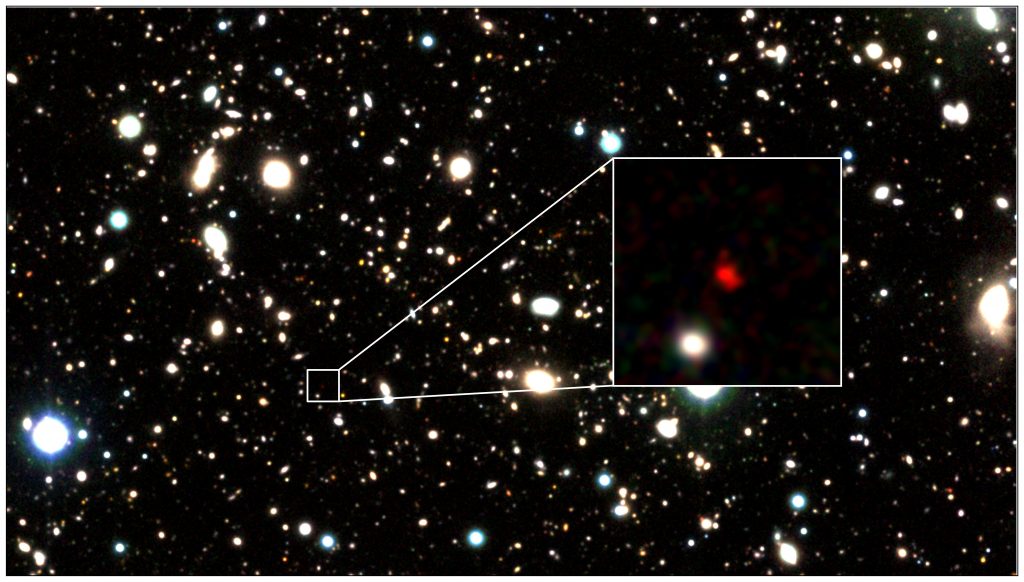We know the universe is expanding, and we have a pretty good idea of how fast it’s expanding, but we don’t know the rate exactly. That’s because of the different methods we have to measure the rate of cosmic expansion keep giving us slightly different results. It’s a nagging problem that bugs astronomers, so while they have worked to ensure current methods are accurate, they have also looked to new ways to measure cosmic expansion. One of these new ways involves gravitational waves.
Continue reading “Colliding Black Holes Provide Another way to Measure Distance in the Universe”Primordial Black Holes Could Have Triggered the Formation of Supermassive Black Holes
The early moments of the universe were turbulent and filled with hot and dense matter. Fluctuations in the early universe could have been great enough that stellar-mass pockets of matter collapsed under their own weight to create primordial black holes. Although we’ve never detected these small black holes, they could have played a vital role in cosmic evolution, perhaps growing into the supermassive black holes we see today. A new study shows how this could work, but also finds the process is complicated.
Continue reading “Primordial Black Holes Could Have Triggered the Formation of Supermassive Black Holes”Astronomers Measure the Signal of Dark Matter From 12 Billion Years ago
Although the particles of dark matter continue to allude us, astronomers continue to find evidence of it. In a recent study, they have seen its effect from the edge of visible space, when the universe was just 1.5 billion years old.
Continue reading “Astronomers Measure the Signal of Dark Matter From 12 Billion Years ago”The Record for the Farthest Galaxy just got Broken Again, now just 250 million years after the Big Bang

In a recent study submitted to MNRAS, a collaborative research team has utilized the first set of data from the James Webb Space Telescope (JWST) discovering a galaxy candidate, CEERS-93316, that formed approximately 250 million years after the Bing Bang, which also set a new redshift record of z = 16.7. This finding is extremely intriguing as it demonstrates the power of JWST, which only started sending back its first set of data a few weeks ago. CEERS stands for Cosmic Evolution Early Release Science Survey, and was specifically created for imaging with JWST.
Continue reading “The Record for the Farthest Galaxy just got Broken Again, now just 250 million years after the Big Bang”These Galaxies are Definitely Living in a Simulation
Studying the universe is hard. Really hard. Like insanely, ridiculously hard. Think of the hardest thing you’ve ever done in your life, because studying the universe is quite literally exponentially way harder than whatever you came up with. Studying the universe is hard for two reasons: space and time. When we look at an object in the night sky, we’re looking back in time, as it has taken a finite amount of time for the light from that object to reach your eyes. The star Sirius is one of the brightest objects in the night sky and is located approximately 8.6 light-years from Earth. This means that when you look at it, you’re seeing what it looked like 8.6 years ago, as the speed of light is finite at 186,000 miles per second and a light year is the time it takes for light to travel in one year. Now think of something way farther away than Sirius, like the Big Bang, which supposedly took place 13.8 billion years ago. This means when scientists study the Big Bang, they’re attempting to look back in time 13.8 billion years. Even with all our advanced scientific instruments, it’s extremely hard to look back that far in time. It’s so hard that the Hubble Space Telescope has been in space since 1990 and just recently spotted the most distant single star ever detected in outer space at 12.9 billion light-years away. That’s 30 years of scanning the heavens, which is a testament to the vastness of the universe, and hence why studying the universe is hard. Because studying the universe is so hard, scientists often turn to computer simulations, or models, to help speed up the science aspect and ultimately give us a better understanding of how the universe works without waiting 30 years for the next big discovery.
Continue reading “These Galaxies are Definitely Living in a Simulation”Why Believing in the Multiverse Isn’t Madness

What is the multiverse? The idea that the universe we inhabit is just one of many parallel universes gets a superhero shout-out in “Doctor Strange in the Multiverse of Madness,” the latest movie based on Marvel comic-book characters.
And in the opinion of Brian Greene, a theoretical physicist at Columbia University, giving some screen time to the multiverse isn’t such a bad thing — even if the plot has some horror-movie twists.
“I think it’s really good if some of these ideas are brought out in a variety of different ways,” Greene says in the latest episode of the Fiction Science podcast, which focuses on the realm where science and technology intersect with fiction and popular culture.
Continue reading “Why Believing in the Multiverse Isn’t Madness”A New Record for the Most Distant Galaxy, Seen Just 300 Million Years After the Big Bang

Since the Renaissance astronomer Galileo Galilee first studied the heavens using a telescope he built himself, astronomers have been pushing the boundaries of what they can observe. After centuries of progress, they have been able to study and catalog objects in all but the earliest periods of the Universe. But thanks to next-generation instruments and technologies, astronomers will soon be able to observe the “Cosmic Dawn” era – ca. 50 million to billion years after the Big Bang.
In recent years, astronomers have made discoveries that preview what this will be like, the most recent of which is the galaxy candidate known as HD1. This galaxy is about 13.5 billion light-years from Earth (32.2 billion light-years in terms of “proper distance“), making it the farthest ever observed. This discovery implies that galaxies existed as early as 300 million years after the Big Bang, a finding which could have drastic implications for astronomy and cosmology!
Continue reading “A New Record for the Most Distant Galaxy, Seen Just 300 Million Years After the Big Bang”New Simulation Recreates an Early Time in the Universe That Still Hasn't Been Seen Directly
The fields of astronomy and astrophysics are poised for a revolution in the coming years. Thanks to next-generation observatories like the James Webb Space Telescope (JWST), scientists will finally be able to witness the formation of the first stars and galaxies in the Universe. In effect, they will be able to pierce the veil of the Cosmic Dark Ages, which lasted from roughly 370,000 years to 1 billion years after the Big Bang.
During this period, the Universe was filled with clouds of neutral hydrogen and decoupled photons that were not visible to astronomers. In anticipation of what astronomers will see, researchers from the Harvard & Smithsonian Center for Astrophysics (CfA), the Massachusetts Institute of Technology (MIT), and the Max Planck Institute for Astrophysics (MPIA) created a new simulation suite called Thesan that simulates the earliest period of galaxy formation.
Continue reading “New Simulation Recreates an Early Time in the Universe That Still Hasn't Been Seen Directly”Is the Universe Fine-Tuned for Life?
For decades, various physicists have theorized that even the slightest changes in the fundamental laws of nature would make it impossible for life to exist. This idea, also known as the “Fine-Tuned Universe” argument, suggests that the occurrence of life in the Universe is very sensitive to the values of certain fundamental physics. Alter any of these values (as the logic goes), and life would not exist, meaning we must be very fortunate to be here!
But can this really be the case, or is it possible that life can emerge under different physical constants, and we just don’t know it? This question was recently tackled by Luke A. Barnes, a postdoctoral researcher at the Sidney Institute for Astronomy (SIA) in Australia. In his recent book, A Fortunate Universe: Life in a Finely Tuned Cosmos, he and Sydney astrophysics professor Geraint F. Lewis argued that a fine-tuned Universe makes sense from a physics standpoint.
Continue reading “Is the Universe Fine-Tuned for Life?”A Gravitational Wave Observatory on the Moon Could "Hear" 70% of the Observable Universe
Gravitational-wave astronomy is set to revolutionize our understanding of the cosmos. In only a few years it has significantly enhanced our understanding of black holes, but it is still a scientific field in its youth. That means there are still serious limitations to what can be observed.
Continue reading “A Gravitational Wave Observatory on the Moon Could "Hear" 70% of the Observable Universe”






